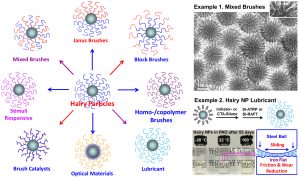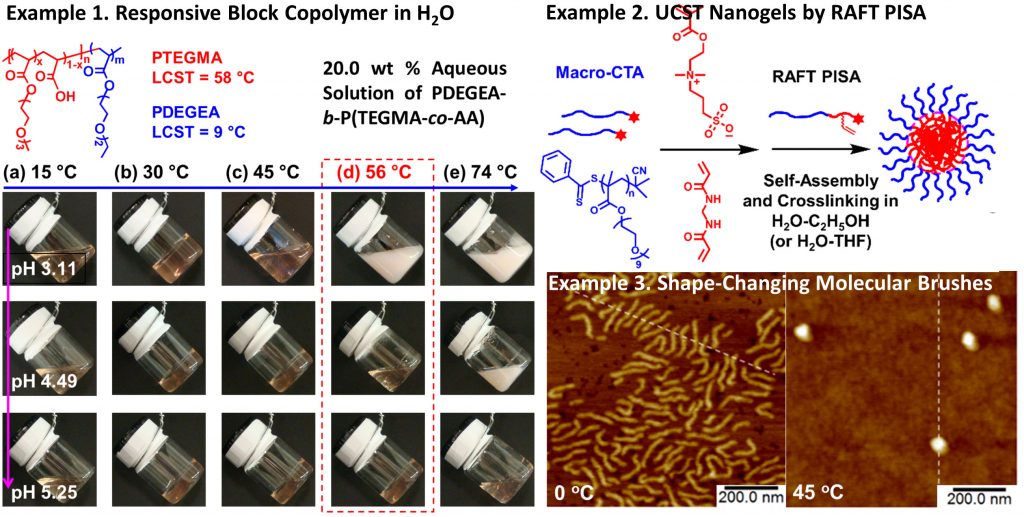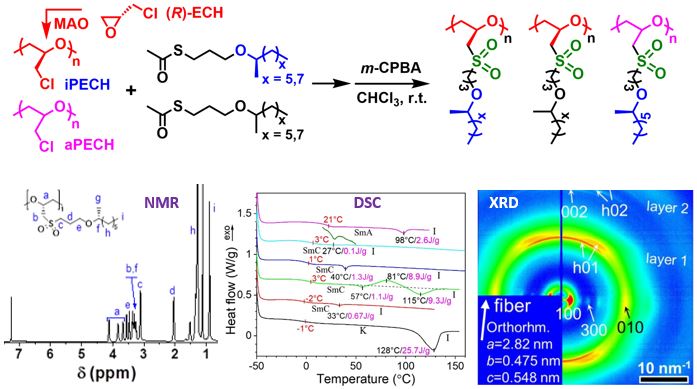Polymer Science, Organic Synthesis, Materials Chemistry, Surface and Colloidal Science, Environmental Chemistry
Our research program centers on responsive, functional organic and organic-inorganic hybrid materials, including macromolecular brushes, stimuli-responsive polymers, chiral liquid crystalline polymers, and polymer adsorbents. These materials are designed for answering fundamental questions, elucidating structure-behavior/property relationships, or pursuing specific applications. “Living”/controlled polymerization techniques, such as atom transfer radical polymerization, reversible addition-fragmentation chain transfer polymerization, ring-opening polymerization, ring-opening metathesis polymerization, etc., are being employed to prepare (well-defined) polymers and organic-inorganic hybrid materials along with organic chemistry tools. Our organic and hybrid materials have (potential) applications in energy efficiency and conversion, antifouling, substance delivery, remediation of environmental pollutants, etc.
1. Macromolecular Brush Materials
Polymer brushes are an assembly of macromolecular chains covalently grafted with a sufficiently high grafting density on a substrate, either a flat surface (commonly called polymer brushes), or (nano)particles (hairy or brush particles), or a polymer backbone (molecular bottlebrushes or bottlebrush polymers). In all these systems, polymer chains exhibit deformed, stretched conformations under equilibrium conditions due to the dense grafting. The intriguing structures and properties of macromolecular brush materials have attracted tremendous attention in the past decades. We are especially interested in synthesis, structure, behavior, and application of stimuli-responsive and multicomponent polymer brushes with well-defined architectures on flat and curved substrates as well as bottlebrush polymers. Current projects include: (i) new synthetic strategies for preparing well-defined multicomponent surface brushes and bottlebrushes with unique architectures, (ii) fundamental understanding of self-assembly behavior of multicomponent brushes in solution, at interfaces, and in bulk matrices, and (iii) applications of brush materials in oil lubrication, advanced polymer nanocomposites, stimuli-responsive emulsions, and encapsulation of proteins, DNA, and RNA.

2. Stimuli-Responsive Polymers
Stimuli-responsive polymers exhibit relatively large and abrupt physical or chemical changes, often accompanied with a drastic solubility change in solvents, in response to external stimuli. The changes can be reversible or irreversible, and various stimuli (e.g., temperature, pH, light, and specific species)-responsive polymers have been reported in the literature. We are interested in (i) new stimuli-responsive polymers, particularly thermoresponsive zwitterionic polymers that display lower critical solution temperature (LCST) and upper critical solution temperature (UCST) transitions in water, (ii) micelles and micellar hydrogels of stimuli-responsive block copolymers, hairy nanogels and microgels, and macroscopic polymer hydrogels, (iii) stimuli-responsive shape-changing bottlebrush polymers, and (iv) thermoresponsive polymers in industrially important organic liquids and organogels. The following shows examples of multiresponsive block copolymer micellar hydrogels, UCST-type thermoresponsive hairy nanogels by reversible addition-fragmentation chain transfer polymerization-induced self-assembly (RAFT-PISA), and stimuli-responsive shape-changing molecular brushes.

3. Chiral Liquid Crystalline Polymers
Chiral liquid crystalline polymers (LCPs) hold potential in electronic and electrooptical applications. However, traditional chiral smectic C (SmC*) LCPs display rather small spontaneous polarization (Ps) due to the use of bulky aromatic mesogens and weak dipolar groups, which has effectively hindered the practical use of ferroelectric LCPs. To seek large Ps, we are designing and synthesizing mesogen-free LCPs by incorporating highly dipolar sulfonyl groups into the alkyl side chains of polyethers. To induce the formation of SmC* phases, we introduce chiral centers into either the polymer backbone or aliphatic side chains or both. Ring-opening polymerization is employed to prepare comb-like mesogen-free LCPs along with post-polymerization modification reactions. These polymers are characterized by 1H and 13C NMR spectroscopy, size exclusion chromatography, polarimetry, and thermogravimetric analysis, and their liquid crystalline behavior and structures are investigated by differential scanning calorimetry, synchrotron X-ray diffraction, and polarized light microscopy.

4. Polymer Adsorbents for Removal of Toxic Oxyanions from Water
Oxyanions are polyatomic oxygen-containing negatively charged ions with a relatively large size, many of which, e.g., perchlorate, arsenate, tellurate, etc., are toxic even at trace levels and are highly persistent and mobile in aqueous environments. For example, in considering the health risk of perchlorate, the California Department of Public Health has set a maximum contaminant level of 6 micrograms/L (6 ppb) for perchlorate in drinking water. We are designing and synthesizing highly efficient polymer adsorbents for the removal of selected hazardous oxyanions from water on the basis of the improved understanding of the interactions between anions and cations and between polymers and anions gained in the past decades. Various organic materials, including brush materials and microporous polymers, will be prepared and examined. In addition, we are developing analytical methods to detect the trace amounts of specific oxyanions in aqueous solutions.